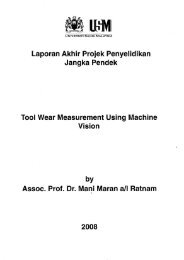design and development of a secure wireless ... - ePrints@USM
design and development of a secure wireless ... - ePrints@USM
design and development of a secure wireless ... - ePrints@USM
Create successful ePaper yourself
Turn your PDF publications into a flip-book with our unique Google optimized e-Paper software.
packet lost. They recommended the integration <strong>of</strong> the system with a GIS/GPS<br />
system for ambulance vehicle control <strong>and</strong> management.<br />
Yamamoto (1995) studied the feasibility <strong>of</strong> <strong>wireless</strong> portable teleradiology <strong>and</strong><br />
facsimile (fax) transmission using a pocket cellular phone <strong>and</strong> a notebook<br />
computer to obtain immediate access to consultants at any location. The system<br />
<strong>design</strong>ed using a desktop personal computer (PC) with a 80486DLC-33<br />
microprocessor, 340-MB hard disk, 1-MB color super Video Graphics Array<br />
(VGA), <strong>and</strong> Windows 3.1, was used to send images to a portable <strong>wireless</strong><br />
receiving unit. A 24,000-baud modem was used in this sending unit <strong>and</strong> a<br />
Gateway 2000 H<strong>and</strong>book notebook computer was used as a test unit to receive<br />
image files. The system scanned <strong>and</strong> stored elbow X-rays <strong>and</strong> CT scans into<br />
the desktop PC <strong>and</strong> transmitted to the portable notebook via the cellular<br />
modem using a modification <strong>of</strong> the PC-teleradiology <strong>and</strong> faxing ECGs from a<br />
conventional fax machine to the cellular laptop unit was successfully tested. The<br />
author found that <strong>wireless</strong> teleradiology <strong>and</strong> fax transmission over cellular<br />
communication systems are feasible with current technology.<br />
The feasibility <strong>of</strong> <strong>wireless</strong> pocket teleradiology had been further implemented by<br />
Yamamoto <strong>and</strong> Williams (2000). They demonstrated how brain computed<br />
tomography (CT) scan images <strong>of</strong> five neurosurgical emergency cases were<br />
received on a pocket computer via a <strong>wireless</strong> modem link. They selected two<br />
pocket computers for trial; (1) The Hewlett Packard 620LX, a pocket computer<br />
with a 256 color 640 by 240 pixel screen, measuring 19.5 by 10.0 by 3.2 cm,<br />
weighing 603 grams <strong>and</strong> (2) The Sharp Mobilon 4500, a pocket computer with a<br />
19

















